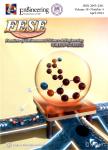Electricity-driven ammonia oxidation and acetate production in microbial electrosynthesis systems
作者机构:Fujian Provincial Key Laboratory of Soil Environmental Health and RegulationCollege of Resources and EnvironmentFujian Agriculture and Forestry UniversityFuzhou 350002China State Key Joint Laboratory of Environment Simulation and Pollution ControlSchool of EnvironmentTsinghua UniversityBeijing 100084China
出 版 物:《Frontiers of Environmental Science & Engineering》 (环境科学与工程前沿(英文))
年 卷 期:2022年第16卷第4期
页 面:27-36页
核心收录:
学科分类:081702[工学-化学工艺] 08[工学] 0817[工学-化学工程与技术]
基 金:This work was supported by the National Natural Science Foundation of China(Grant No.51908131) the Natural Science Foundation of Fujian Province(No.2020J01563) the Special Fund of State Key Joint Laboratory of Environment Simulation and Pollution Control(No.19K05ESPCT) the CAS Key Laboratory of Environmental and Applied Microbiology&Environmental Microbiology Key Laboratory of Sichuan Province,Chengdu Institute of Biology,Chinese Academy of Sciences(No.KLCAS-2019-1)
主 题:Biocathode Carbon dioxide Electrochemical oxidation Graphite anode Boron-doped diamond
摘 要:Microbial electrosynthesis(MES)is an emerging technology for producing chemicals,and coupling MES to anodic waste oxidation can simultaneously increase the competitiveness and allow additional functions to be *** this study,MES was used for the simultaneous removal of ammonia from synthetic urine and production of acetate from CO_(2).Using graphite anode,83.2%±5.3%ammonia removal and 28.4%±9.9%total nitrogen removal was achieved,with an energy consumption of 1.32 kWh/g N for total nitrogen removal,0.45 kWh/g N for ammonia nitrogen removal,and 0.044 kWh/g for acetate *** boron-doped diamond(BDD)anode,70.9%±12.1%ammonia removal and 51.5%±11.8%total nitrogen removal was obtained,with an energy consumption of 0.84 kWh/g N for total nitrogen removal,0.61 kWh/g N for ammonia nitrogen removal,and 0.043 kWh/g for acetate production.A difference in nitrate accumulation explained the difference of total nitrogen removal *** of ammonia and acetate across the membrane deteriorated the performance of *** results are important for the development of novel elcctricity-driven technologies for chemical production and pollution removal.



